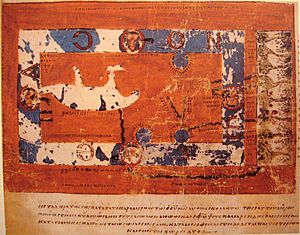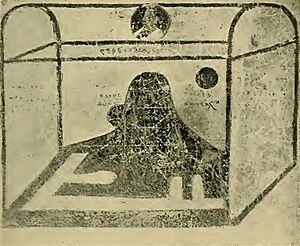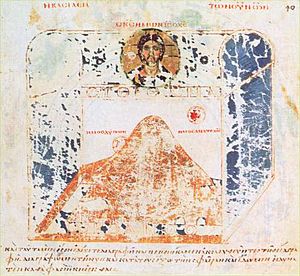Cosmas Indicopleustes facts for kids

Cosmas Indicopleustes (which means "Cosmas who sailed to India") was a Greek merchant and later a hermit. He lived in Alexandria, Egypt, in the 6th century. Cosmas was a great traveler who made many trips to India during the time of Emperor Justinian I. He wrote an important book called Christian Topography, which included some of the earliest and most famous world maps. Cosmas followed the Church of the East.
Contents
Cosmas's Amazing Journeys
Around the year 550 AD, Cosmas wrote his book, Christian Topography. This book was filled with pictures and was based on his own adventures as a merchant. He sailed across the Red Sea and the Indian Ocean in the early 500s. His descriptions of India and Ceylon from that time are very helpful for historians today.
Cosmas likely visited the Kingdom of Axum (which is now northern Ethiopia) and Eritrea. He also traveled to India and Ceylon.
What Does "Indicopleustes" Mean?
The name "Indicopleustes" means "Indian voyager." It comes from a Greek word that means "to sail." People had traded between the Roman Empire and India for a long time. But Cosmas's book is special because it's one of the few written by someone who actually made the long journey.
He described and even drew some of the things he saw in his Topography. Some of these drawings were copied into later versions of his book. In 522 AD, Cosmas visited the Malabar Coast in South India. He was the first traveler to mention Syrian Christians living in what is now Kerala, India. He wrote that there was a Christian church in Ceylon, and also in a place called Malé, where pepper grows. He also mentioned a bishop in the town of Kalliana (today's Kalyan), who was appointed from Persia.
Cosmas's View of the World
A big part of Cosmas's book, Christian Topography, was his idea about the shape of the world. He believed the world was flat. He thought the heavens looked like a box with a curved lid. He didn't agree with thinkers like Ptolemy who said the Earth was round.
Cosmas wanted to show that older geographers were wrong about a spherical Earth. He thought the Earth was shaped like the tabernacle, a special tent for worship described in the Bible. However, the idea of a flat Earth was not common among educated people in the Western world since about 300 BC. Even in religious groups, Cosmas's view wasn't very popular. Many Christian thinkers of his time, like John Philoponus, disagreed with him.
Historian David C. Lindberg said that Cosmas wasn't very important in his own time. But he is often used to suggest that most medieval people believed the Earth was flat. Lindberg says this idea is "totally false." Cosmas is actually the only European from that time known to have believed in a flat Earth. Most educated people, sailors, and travelers believed the Earth was round.
Even with his unique ideas about the Earth's shape, Cosmas gives us a fascinating and reliable look into a world that no longer exists. For example, around 525 AD, he was in Adulis (on the coast of modern Eritrea). At that time, the King of Axum was getting ready to fight the Jewish king Dhu Nuwas in Yemen. Dhu Nuwas had been treating Christians badly. Cosmas recorded important writings from that time, like the Monumentum Adulitanum, which have since disappeared.
See also
 In Spanish: Cosmas Indicopleustes para niños
In Spanish: Cosmas Indicopleustes para niños



